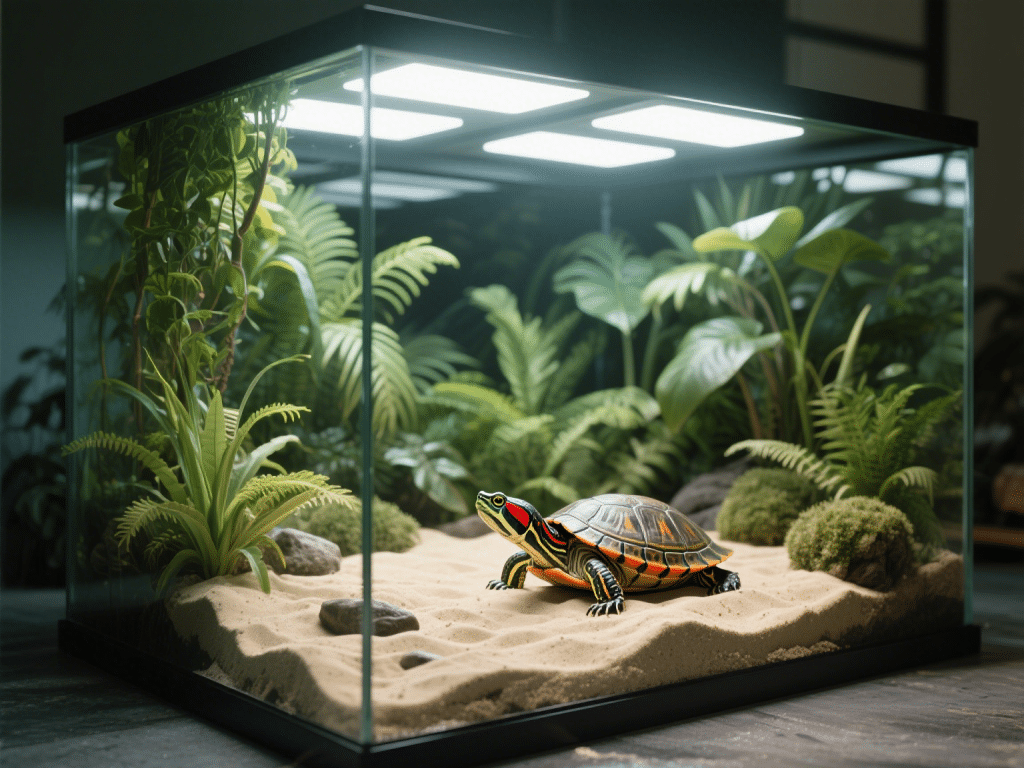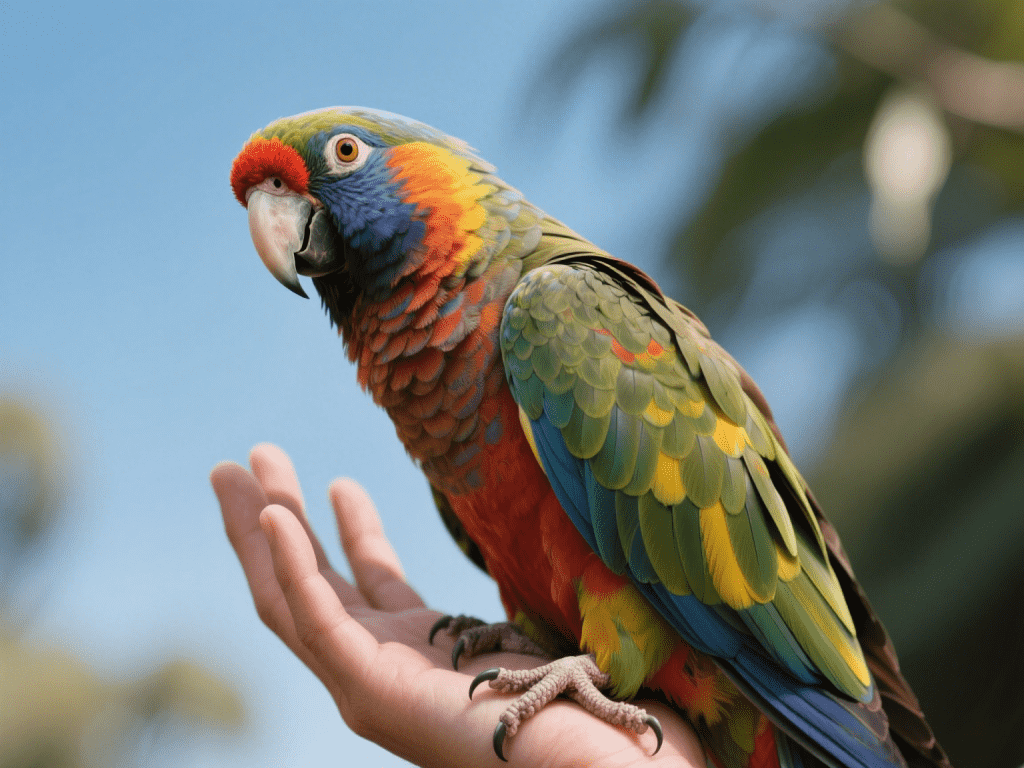
Creating an indoor terrarium that meets the complex needs of freshwater turtles requires more than just filling a tank with water and a rock. Turtles demand precise temperature gradients, high‑quality UV lighting, varied substrate textures, and engaging décor to thrive physically and mentally. Drawing on over fifteen years of consulting for reptile exhibits and private enthusiasts, this guide unpacks every aspect of terrarium design—from lighting layout and temperature control to substrate layering, décor placement, and maintenance routines—ensuring your shelled companion enjoys a healthy, stimulating habitat year‑round.
1. Spatial Planning & Water‑Land Ratio
Optimal Space Requirements:
Tank Size: As a general rule, provide 10 gallons of water for every inch of adult shell length. For a 6 in shell, a 60 gal tank (227 L) is the bare minimum.
Water‑Land Proportion: Aim for a 2:1 water-to-land ratio or at least 1:1. A large water area supports swimming and exercise, while a spacious land platform enables basking and foraging behaviors.
Land Platform Design:
Platforms & Ramps: Use non‑slip materials such as textured slate or untreated wood to build ramps that allow turtles to climb easily from water to basking zones. Ensure ramps are sturdy and at a gentle incline (no greater than 30°).
Zone Separation: Position the platform at one end of the tank to concentrate basking heat and lighting, leaving the rest of the enclosure mainly aquatic.
2. Lighting & Temperature Control
Proper lighting and thermal gradients are vital for shell development, digestion, and overall health.
A. UVB & UVA Lighting
UVB Source: Install a high‑output linear fluorescent UVB tube (5–10% UVB) 8–12 inches above the basking area. Replace these bulbs every six months, even if they still emit visible light, since UV output diminishes over time.
UVA/Aesthetic Lighting: Complement UVB with full‑spectrum LED daylight bulbs to simulate natural light conditions and enhance color. Maintain a 10–12 hour photoperiod using timers for consistency.
B. Heat Lamps & Temperature Gradient
Basking Lamp: Position a ceramic heat emitter or infrared heat lamp 8–10 inches above the land platform to produce a basking spot temperature of 90–95 °F (32–35 °C).
Ambient Air & Water Temperature:
Air (non‑basking): Maintain around 75–80 °F (24–27 °C).
Water: Use an aquarium heater set to 75–80 °F (24–27 °C) with an external thermostat for precise control.
Monitoring: Place digital thermometers at the basking platform, midpoint of water depth, and opposite corner on the land area to confirm stable gradients.
3. Substrate Selection & Terrain Features
The right substrate supports health, hygiene, and natural behaviors.
A. Aquatic Zone
Bare Bottom vs. Gravel: A bare bottom simplifies cleaning and prevents impaction risk, but large, smooth river stones can add enrichment if rinsed thoroughly. Avoid small gravel that turtles could ingest.
B. Land Zone
Layered Substrate: Create a 2–3 inch deep layer combining washed play sand with coconut coir or orchid bark. This mixture retains moisture, supports burrowing, and provides good drainage.
Spot Clean & Full Change: Remove soiled substrate daily; perform a complete replacement every 4–6 months.
C. Terrain Variation
Rocks & Driftwood: Anchor flat stones to form ledges and create elevation changes. Include untreated driftwood pieces for unstable surfaces that challenge turtles’ balance, promoting physical fitness.
Hiding Spots: Construct caves or shelters using large ceramic flower pots laid on their sides or purpose‑built reptile hides, giving turtles a secure retreat.
4. Décor & Enrichment Elements
Environmental enrichment prevents boredom and encourages natural exploration.
A. Live & Artificial Plants
Non‑Toxic Live Varieties: Use hardy species like Anubias, Java fern, and aquatic pothos anchored in pots; these absorb nitrates and provide hiding spots.
High‑Quality Artificial Plants: Strategically place plastic or silk foliage for dens and visual complexity, ensuring no loose parts can be ingested.
B. Interactive Structures
Floating Platforms: Cork bark or EPS foam docks let turtles bask and can be repositioned periodically for novelty.
Puzzle Feeders: Hang floating mesh bags with lettuce or vegetables, requiring turtles to nudge and manipulate them to access food.
Target Training Stations: Mount a colored plastic knob above the waterline; teach turtles to touch it for a pellet reward, stimulating cognition.
5. Maintenance & Safety Protocols
A rigorous cleaning and safety routine safeguards both turtles and their human caretakers.
A. Daily Checks
Water Quality: Test pH, ammonia, nitrite, and nitrate weekly. Perform partial water changes (20–30%) as needed.
Thermal & Lighting Systems: Verify timers, bulbs, and heaters function correctly. Replace lamps on schedule.
B. Weekly & Monthly Tasks
Filter Maintenance: Rinse mechanical pre-filters in dechlorinated water weekly; replace chemical media (carbon) monthly.
Full Deep Clean: Every 3–4 months, dismantle décor, scrub with reptile‑safe disinfectant, and rinse thoroughly before reassembling.
C. Hazard Prevention
Electrical Safety: Secure cords in protective conduits well away from water. Use GFCI‑protected outlets.
Sharp Edge Inspection: Smooth or remove any brittle plastic or rough wood that could injure turtles.
By integrating proper lighting, thermal zoning, substrate diversity, and engaging décor—backed by disciplined maintenance—you’ll craft an indoor terrarium that mirrors the complexity of a wild shoreline. These design principles not only optimize your turtle’s health, shell integrity, and behavior but also create a captivating display of reptilian life in your home.









Comments on " Designing a Turtle-Friendly Indoor Terrarium: Lighting, Substrate & Décor" :